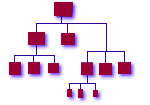


|

|
|
home | sitemap | abstract | introduction | chaos | thinking | checklist | migrating | recovery pushpull | cost | career | workshop | isconf | list_and_community | papers | references |
File Replication ServersPrerequisites: Directory Servers, Time Synchronization Some configuration files will always have to be maintained on the client's local hard drive. These include much of /etc/*, and in our case, the entire /usr/local tree. How much you keep on your local disk is largely determined by how autonomous you want your machines to be. We periodically replicated changed files from the gold server to the local hard disks. We needed a fast, incremental and mature file replication tool. We chose Carnegie Mellon's SUP (Software Upgrade Protocol) [sup] . We would have preferred a flexible, portable, open-source caching file system, but since none were available we opted for this "poor man's caching" instead. It worked very well. Aside from the advantage of incremental updates, SUP offered a strict "pull" methodology. The client, not the server, chose the point in time when it would be updated. (See Push vs. Pull ) . Using this mechanism, we were able to synchronize the files in /etc on every client every six minutes, and the contents of /usr/local every hour. (This on a trading floor with over 800 clients.) We also replicated selected applications from the NFS servers to the client hard disks. (See Client Application Management ) . We have at times used SUP to replicate most of the files that NIS normally manages, like /etc/services and the automounter maps. If using NIS, we prefer to use it to manage authentication only -- the passwd map. A more recent development, familiar to many open source developers and users, is CVSup [polstra] . With ordinary SUP, we had to do a 'cvs update' in the replication source tree on the gold server to check the latest changes out of the CVS repository. We then used SUP jobs in crontab to pull the changes from there down to the client. Today it may make more sense to skip the intermediary step, and instead use CVSup to pull files and deltas directly from the CVS repository into the live locations on the client hard disks. |
|
||||||||
|
© Copyright 1994-2007 Steve
Traugott,
Joel Huddleston,
Joyce Cao Traugott
In partnership with TerraLuna, LLC and CD International |
||||||||